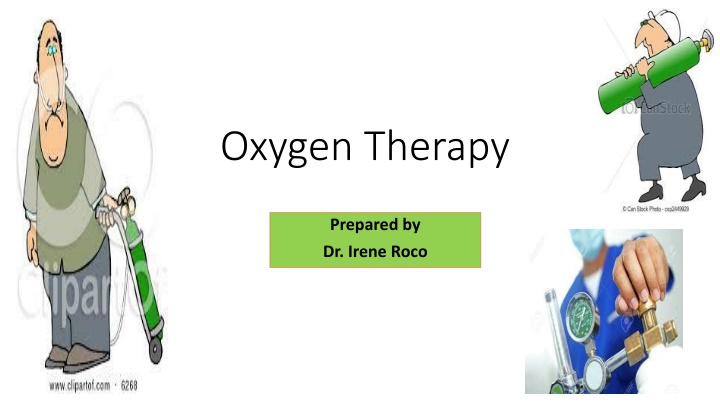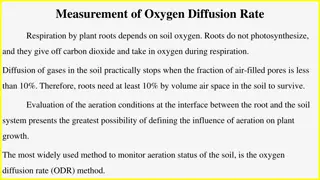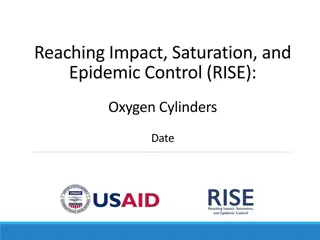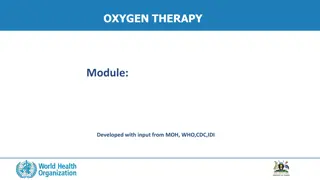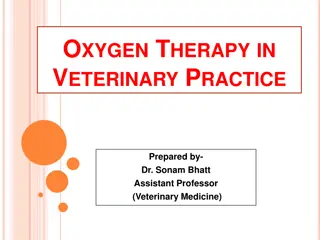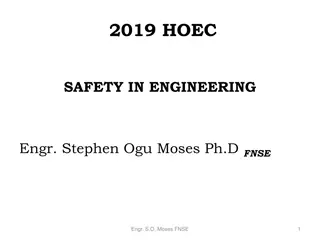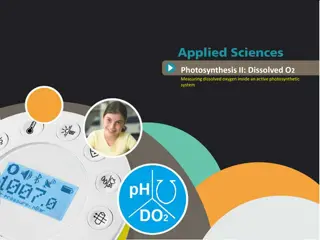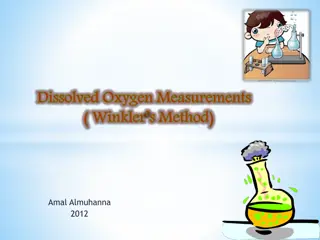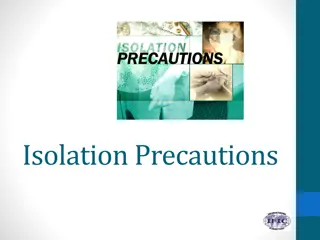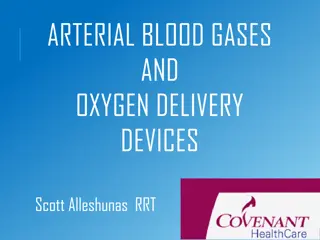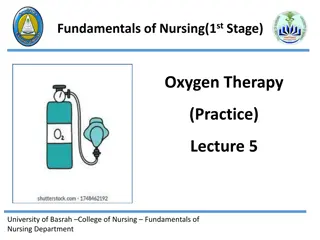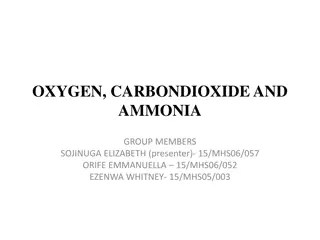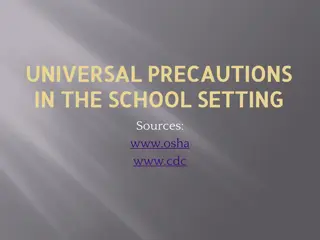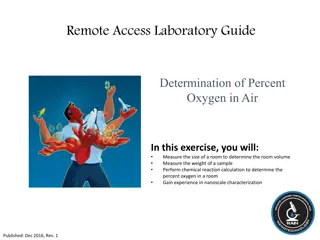Comprehensive Guide to Oxygen Therapy and Safety Precautions
Oxygen therapy is a crucial medical intervention for various conditions, such as hypoxia, impaired gas exchange, and heart failure. This guide covers the administration of oxygen, types of oxygen supply, safety precautions, and devices used for oxygen delivery. Safety measures include avoiding smoking near oxygen equipment, using non-flammable materials, and ensuring proper grounding of electrical equipment. Understanding the proper administration and safety protocols is essential for effective patient care.
Download Presentation

Please find below an Image/Link to download the presentation.
The content on the website is provided AS IS for your information and personal use only. It may not be sold, licensed, or shared on other websites without obtaining consent from the author.If you encounter any issues during the download, it is possible that the publisher has removed the file from their server.
You are allowed to download the files provided on this website for personal or commercial use, subject to the condition that they are used lawfully. All files are the property of their respective owners.
The content on the website is provided AS IS for your information and personal use only. It may not be sold, licensed, or shared on other websites without obtaining consent from the author.
E N D
Presentation Transcript
Oxygen Therapy Prepared by Dr. Irene Roco
Oxygen therapy Oxygen therapy is the administration of oxygen as a medical intervention, which can be for a variety of purposes in both chronic and acute patient care Oxygen is often prescribed for people to prevent hypoxia because of the following conditions: 1.difficulty ventilating all areas of their lungs 2.Impaired gas exchange 3.Heart failure Prescribed by the physician who specifies the following: 1.Concentration 2. liter per minute 3.Method of delivery
Oxygen supply Oxygen supply 1. Piped in wall outlets at the client s bedside 2. Portable (Tanks or cylinders) for transporting oxygen dependent clients, in home use; Humidifier add water vapor to inspired air because Oxygen is a dry gas that dehydrates respiratory mucous membrane Prevents mucous membrane from drying and becoming irritated Loosens secretions for easier expectoration
Safety Precautions for Oxygen Administration Safety Precautions for Oxygen Administration Teach family members to smoke only outside away from the client and oxygen equipment. Set up No Smoking: and oxygen in Use signs at the site of administration and at the door, according to agency policy. Instruct the client and visitors about the hazard of smoking with oxygen in use Provide cotton gown and blankets . Synthetics and wool may generate sparks of static electricity
Safety Precautions for Oxygen Administration Safety Precautions for Oxygen Administration Avoid the use of volatile, flammable materials such as oils, greases, alcohol, ether and acetone near clients receiving oxygen Remove matches, lighters, ashtrays, and any friction-type or battery operated toys or devices from bedside Be sure that electric monitoring equipment , suction machines, and portable diagnostic machines are electrically grounded. Locate fire extinguishers and oxygen meter turn-off lever.
Various devices used for administration of oxygen. Various devices used for administration of oxygen. Pressure regulator - used to control the high pressure of oxygen delivered from a cylinder (or other source) to a lower pressure. This lower pressure is then controlled by a flowmeter. Flowmeter controls the lower pressure which may be preset or selectable, and this controls the flow in a measure such as litres per minute (lpm).
Oxygen Delivery System Oxygen Delivery System 1. Nasal cannula (NC) is a thin tube with two small nozzles that protrude into the patient's nostrils. Most common and inexpensive device provides oxygen at low flow rates, 2 6 litres per minute (LPM), delivering a concentration of 24 45%. allows the patient to continue to talk, eat and drink while still receiving the therapy. associated with greater overall comfort, and improved oxygenation and respiratory rates than with face mask oxygen.
Oxygen Delivery System Oxygen Delivery System 1. Nasal cannula (NC) Limitation: Unable to deliver higher concentration of oxygen Can be drying and irritating to mucous membrane
Oxygen Delivery System Oxygen Delivery System 2. Simple face mask covers the patient s nose and mouth. Exhalation ports at the sides of the mask allow exhaled CO2 to escape often used at between 5 and 8 LPM, with a concentration of oxygen to the patient of between 40 60%.
Oxygen Delivery System Oxygen Delivery System 3. Air-entrainment masks, also known as Venturi masks, Has a wide bore tubing and color coded jet adapters ( blue adapter 24% at 4-10 lpm; green adapter 35% at 8lpm) can accurately deliver a predetermined oxygen concentration to the trachea up to 24 - 50% at 4- 10 lpm . 4. Partial rebreathing mask has a reservoir bag, which increases the provided oxygen rate to 60 90% oxygen at 6 to 10 LPM.
Oxygen Delivery System Oxygen Delivery System 5. Non-rebreather masks ( reservoir mask), - draw oxygen from an attached reservoir bags, with one-way valves that direct exhaled air out of the mask. Delivers the highest oxygen concentration when properly fitted and used at flow rates of 8-10 LPM or higher, they deliver close to 100% oxygen. This type of mask is indicated for acute medical emergencies.
Oxygen Delivery System Oxygen Delivery System 6. Face Tent Can replace oxygen mask when masks are poorly tolerated by clients Provides oxygen concentration at 30 50% with flow rates of 4- 8 LPM
Oxygen Delivery System Oxygen Delivery System 7. Bag-valve-mask (BVM) - a malleable bag attached to a face mask (or invasive airway such as an endotracheal tube or laryngeal mask airway), usually with a reservoir bag attached, which is manually manipulated by the healthcare professional to push oxygen (or air) into the lungs. Used in many emergency medical service and first aid personnel
Oxygen Delivery System Oxygen Delivery System Characteristic Concentration LPM 1. Nasal Cannula provides oxygen at low flow rates 24 45%. , 2 6 litres per minute (LPM), 2. Simple face mask 40 60%. 5 - 8 LPM 3. Air-entrainment masks also known as Venturi masks, blue adapter 24% green adapter 35% At trachea : 24 - 50% 4-10 lpm; 8 lpm 4- 10 lpm . 4. Partial rebreathing mask has a reservoir bag 60 90% 6 to 10 LPM. 5. Non-rebreather masks ( reservoir mask), Delivers the highest oxygen concentration Close to 100% of 8-10 LPM or higher, they deliver close to 6. Face Tent 30 50% 4- 8 LPM or higher
Lets Review! Let s Review!
References: Kozier & Erb s Fundamentals of Nursing . Eighth Edition
